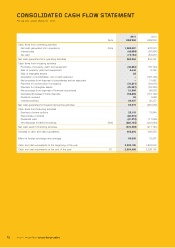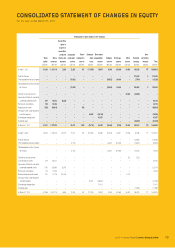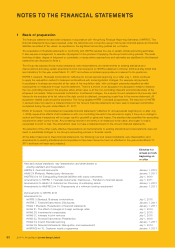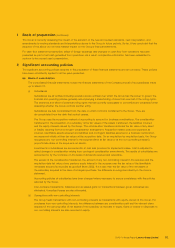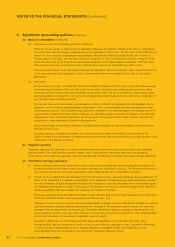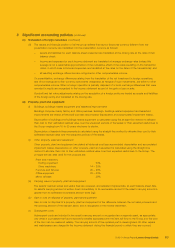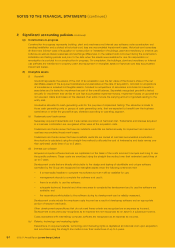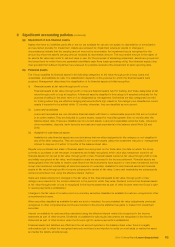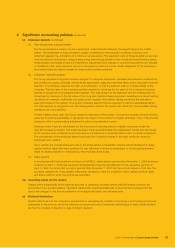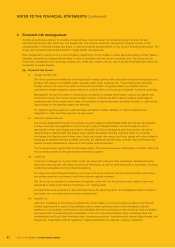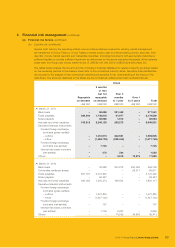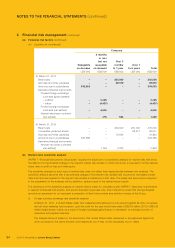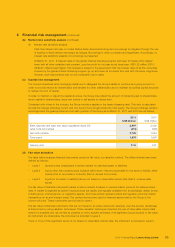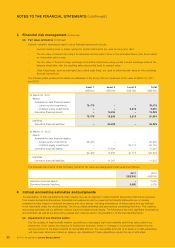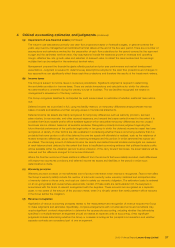Lenovo 2011 Annual Report Download - page 85
Download and view the complete annual report
Please find page 85 of the 2011 Lenovo annual report below. You can navigate through the pages in the report by either clicking on the pages listed below, or by using the keyword search tool below to find specific information within the annual report.
2010/11 Annual Report Lenovo Group Limited
88
NOTES TO THE FINANCIAL STATEMENTS (continued)
2 Significant accounting policies (continued)
(m) Cash and cash equivalents
For the purposes of the cash flow statement, cash and cash equivalents mainly comprise cash on hand, deposits held
at call with banks, highly liquid investments which are subject to an insignificant risk of changes in value, and bank
overdrafts. Bank overdrafts are shown within borrowings in current liabilities on the balance sheet.
(n) Share capital
Ordinary shares are classified as equity.
Convertible preferred shares are mandatorily redeemable on a specific date. The fair value of the liability portion
of convertible preferred shares is determined using a market interest rate for an equivalent non-convertible bond.
This amount is recorded as a liability on an amortized cost basis until extinguished on conversion or maturity of the
convertible preferred shares (Note 2(o)). The remainder of the proceeds is allocated to the conversion option. This is
recognized and included in shareholders’ equity, net of income tax effects. Upon conversion of convertible preferred
shares to voting ordinary shares, the amounts of liability portion and equity portion of respective preferred shares are
reclassified to share capital and share premium.
The dividends on these convertible preferred shares are recognized in the income statement as interest expense.
Incremental costs directly attributable to the issue of new shares or options are shown in equity as a deduction, net of
tax, from the proceeds.
Where any group company purchases the Company’s equity share capital (treasury shares), the consideration paid,
including any directly attributable incremental costs (net of income taxes), is deducted from equity attributable to the
Company’s equity holders until the shares are cancelled or reissued. Where such shares are subsequently reissued, any
consideration received (net of any directly attributable incremental transaction costs and the related income tax effects)
is included in equity attributable to the Company’s equity holders.
(o) Borrowings
Borrowings are recognized initially at fair value, net of transaction costs incurred. Transaction costs are incremental
costs that are directly attributable to the acquisition, issue or disposal of a financial asset or financial liability, including
fees and commissions paid to agents, advisers, brokers and dealers, levies by regulatory agencies and securities
exchanges, and transfer taxes and duties. Borrowings are subsequently stated at amortized cost; any difference
between the proceeds (net of transaction costs) and the redemption value is recognized in the income statement over
the period of the borrowings using the effective interest method.
Borrowings are classified as current liabilities unless the Group has an unconditional right to defer settlement of the
liability for at least 12 months after the balance sheet date.
(p) Trade and other payables
Trade payables are obligations to pay for part components or services that have been acquired in the ordinary course
of business from suppliers. Majority of other payables are obligations to pay for finished goods that have been acquired
in the ordinary course of business from subcontractors. Trade and other payables are classified as current liabilities
if payment is due within one year or less (or in the normal operating cycle of the business if longer). If not, they are
presented as non-current liabilities.
Trade and other payables are recognized initially at fair value and subsequently measured at amortized cost using the
effective interest method.
(q) Provisions
Where there are a number of similar obligations, the likelihood that an outflow will be required in settlement is
determined by considering the class of obligations as a whole. A provision is recognized even if the likelihood of an
outflow with respect to any one item included in the same class of obligations may be small.
Provisions are measured at the present value of the expenditures expected to be required to settle the obligation using
a pre-tax discount rate that reflects current market assessments of the time value of money and the risks specific to the
obligation. The increase in the provision due to passage of time is recognized as interest expense.
(i) Warranty provision
The Group records warranty liabilities at the time of sale for the estimated costs that will be incurred under its basic
limited warranty. The specific warranty terms and conditions vary depending upon the product and the country in
which it was sold, but generally includes technical support, repair parts and labor associated with warranty repair
and service actions. The period ranges from one to three years. The Group reevaluates its estimates on a quarterly
basis to assess the adequacy of its recorded warranty liabilities and adjusts the amounts as necessary.


